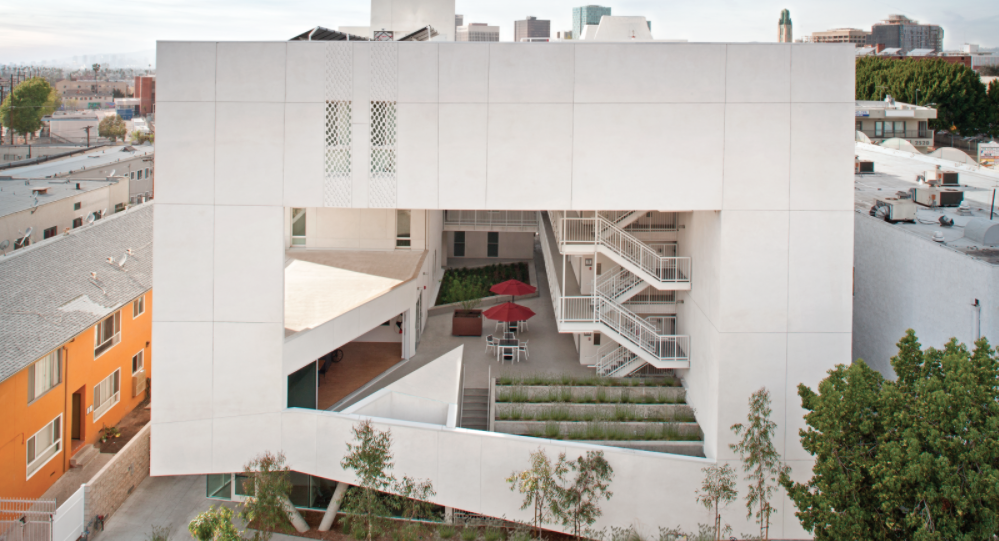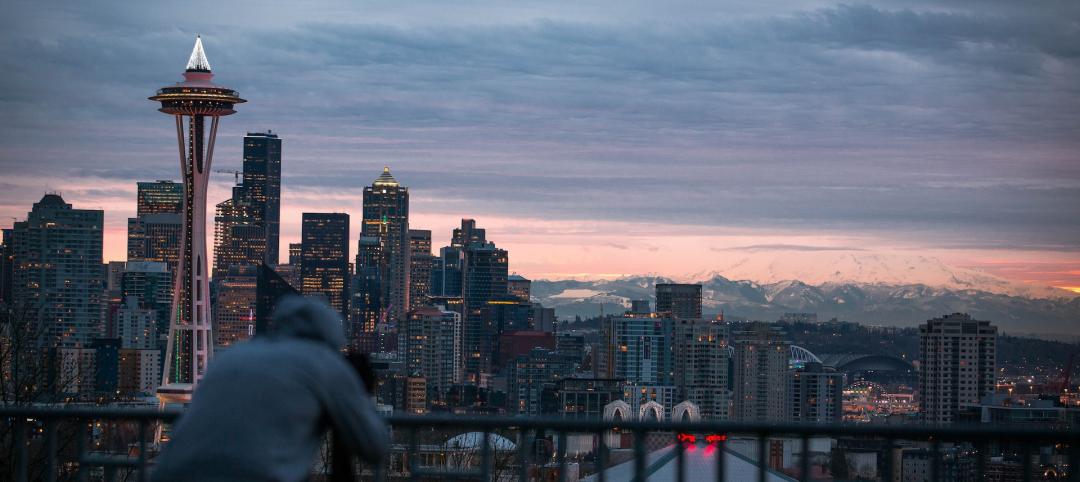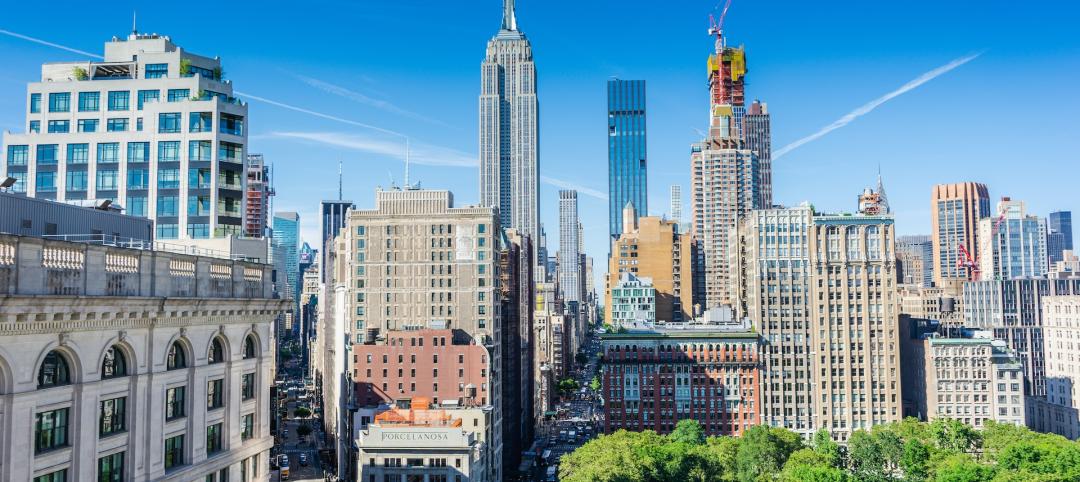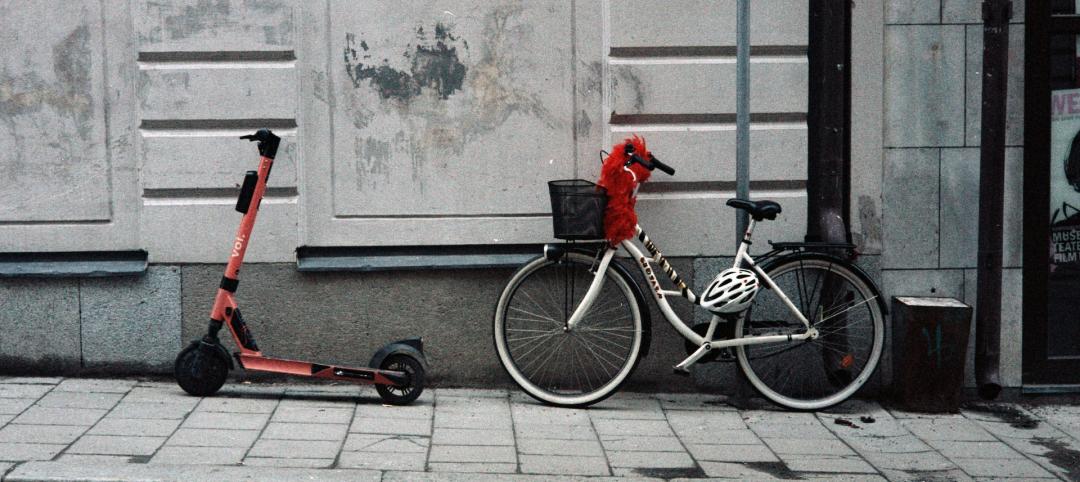For the homeless, the experience of obtaining social services, whether in a soup kitchen, shelter, or free clinic, often means having to encounter institutional buildings marked by dingy walls, stained floors, and annoying fluorescent lights.
“The message people get is, ‘We don’t really care very much about you,’” says Mike Alvidrez, CEO, Skid Row Housing Trust, Los Angeles. “We don’t see that as a healthy way to change one’s life.”
Alvidrez says it’s almost impossible for people to overcome mental, social, and medical problems while they’re homeless. Skid Row Housing Trust’s approach is to provide housing first, so that problems emanating from prolonged poverty, poor health, disabilities, mental illness, or addiction can be addressed, and people can go on to lead “safe, stable lives in wellness.”
To fulfill that mission, Skid Row Housing Trust works with award-winning architects to create masterfully designed “supportive” apartment buildings. “We want these buildings to feel inspirational and aspirational, so residents feel proud of where they live and aspire to do more,” says Alvidrez.
That philosophy certainly applies to The Six, an 18,390-sf building designed by Los Angeles–based Brooks + Scarpa. The Six provides 52 apartments and studio efficiencies for formerly homeless individuals; 18 of the units have been set aside for veterans. The name comes from the military expression “Got your six,” meaning “I’ve got your back.”
DESIGNING A PLACE FOR HEALING
The Six is located at 811 South Carondelet Street in MacArthur Park, one of the highest-density neighborhoods in the U. S.—38,000 per square mile. The architects were aware that successful recovery and rehabilitation for Skid Row Housing’s clients depended on the ability of formerly homeless individuals to be reintroduced into society.
The design of The Six purposely deemphasizes personal space in favor of community space where residents can make connections organically—to others, and to their surroundings.
“Projects like this tend to become very large compact masses, and light and ventilation become real problems,” says Lawrence Scarpa, FAIA, LEED AP, CEO, Brooks + Scarpa. “We wanted the units to be open and light-filled, with good cross-ventilation, and still have privacy for tenants.”

The view from the second-floor podium courtyard into the community room. “For the veterans and other tenants who are suffering from schizophrenia and other problems, the courtyard and community room get them to be among other people,” says Lead Designer Larry Scarpa, FAIA. Photo: Tara Wujcik
The solution was to create a huge five-story white cube with massive holes punched into three sides. Skid Row Housing’s Alvidrez admits that The Six really stands out. “Let’s face it, it’s a box, but, man, what a box!” he says. “The opening in the front is what you notice first: ‘Hey, there’s a big hole in that building. What the hell is that about?’ It sets up a conversation with the community. Homelessness is something we need to talk about. The solution needs to be loud and proud.”
The varying size of the punched holes induces cross-ventilation that takes advantage of the local climate and prevailing breezes. “The air really flows through,” says Brooks + Scarpa Design/Project Manager Diane Thepkhounphithack. The units have huge casement windows that catch the wind. Transom windows over the entry doors allow air and light to penetrate the living spaces.
The emphasis on natural light and airflow reinforces the designers’ focus on promoting physical and emotional healing. “With any form of recovery, being exposed to light, ventilation, and beautiful weather can make a huge difference,” Thepkhounphithack says.
GIVING TENANTS MEANINGFUL OPTIONS
To encourage residents to get out and about instead of hunkering in their rooms, the 45 studio efficiencies (350 sf) and seven one-bedroom units (500 sf) provide just enough room for a bed, bathroom, and small kitchen. Rents are based on income.
The organic nature of the pierced walls opens up an extensive courtyard on the second floor that connects to a community space with sliding glass doors (which are usually kept open during the day). This nexus between the courtyard and the community space can, depending on the needs of the tenant, provide opportunity either for involvement with others, or for privacy.
“Our task was to allow people to interact with others, but at their own choosing,” says Scarpa. “The community room is wide open and connects to the courtyard, so people can interact but still be part of the bigger space.”
The open frame of the building gives residents a feeling of privacy despite the intense density of the neighborhood. “As soon as you put a frame around something, you feel a sense of separation, in a good way,” says Thepkhounphithack. “When you’re on the podium deck, technically you’re exposed because people can see in, but you feel pulled back, and you still have a sense of privacy.”
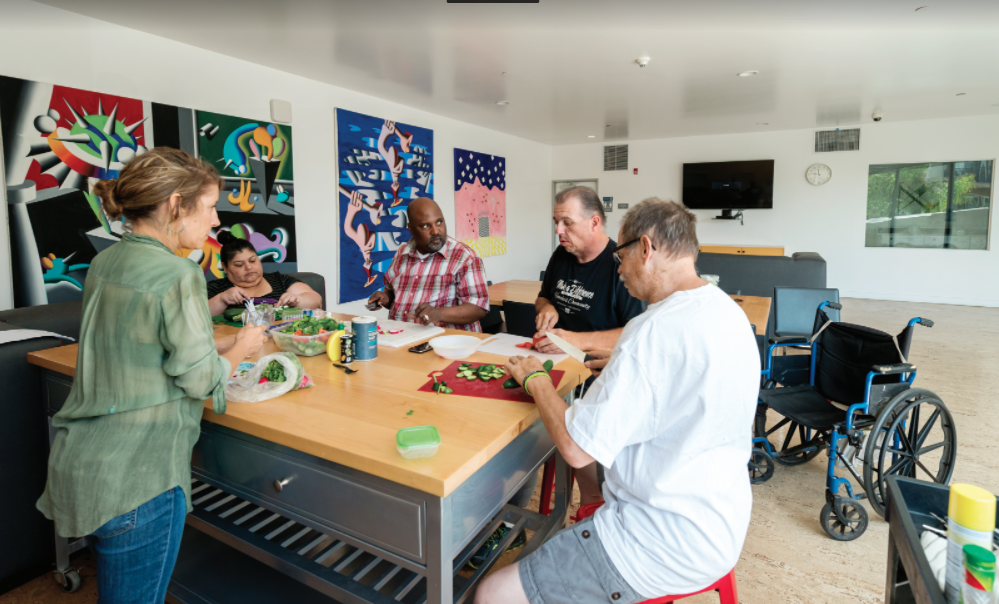
James Grahn, 53 (right, with residents Tony Hill and Robert Odom), served in the Army Signal Corps in Germany, Texas, and California (1982 to 1991), then did a stint in the National Guard (2001 to 2011). “I had a lot of fun in the army,” he says. Before moving to The Six in May, Grahn lived in a friend’s RV, then wound up in a VA hospital. His last stop was a homeless shelter in downtown LA.
Pathways through the building lead to the staircase that connects to the residential units on the upper floors of the five-story structure. That wayfinding pattern was carefully choreographed.
“It’s not the most efficient way to get around,” says Thepkhounphithack. “The pathways are meant to be meandering, to encourage residents to get outside in communal spaces in order to socialize and reconnect with the community.”
Diana Pescar, Resident Services Coordinator with Skid Row Housing , says she’s pleasantly surprised at how well the community space is working. “They’re playing dominoes out there on the picnic tables, stuff you’d see on Skid Row, but now they’re in this safe environment.”
PROVIDING SORELY NEEDED SERVICES
As with all Skid Row Housing projects, The Six has on-site supportive services: primary medical and mental healthcare, individual and group counseling, health and dental screenings, addiction recovery support, and assistance with obtaining government entitlements.
Three case managers—Pescar, Daniel Myatt, and Shanknika Ainsworth—provide intensive case management for all residents, including peer-group counseling, crisis intervention, and hands-on help with applications for Social Security disability and veterans’ benefits. “Because they’ve been homeless, our residents often don’t have their birth certificates or discharge papers,” says Pescar. “We have a direct line to the VA and can get those documents.”
To foster interaction among the residents, the case managers offer classes in improv acting, music appreciation, cooking on a budget, and flower arrangement. Pescar, who has a degree in art education, says she initially got a lot of grief about the flower class. “Oh, the guys’ll never come! That’s all I heard.” But the class is full every week. “That class has taught me that these men have interests that you wouldn’t think possible—aesthetics, gardening, music,” says Pescar.
NO SHORTAGE OF PROBLEMS TO SOLVE
The Six’s team faced more than its fair share of hurdles. The design was well under way when the project had to be moved to a new site. “We had to scramble to produce a quick concept design to show lenders the project was still viable,” says Thepkhounphithack.
The complicated funding package created another set of problems. Skid Row Housing Trust pulled together $10.1 million from a wide array of sources: National Equity Fund, Los Angeles Housing + Community Investment Department, Housing Authority of the City of Los Angeles, Los Angeles County Department of Health Services, California Tax Credit Allocation Committee, Local Initiatives Support Corp., Federal Home Loan Bank of San Francisco, Charles Schwab Bank, Century Housing Corp., and Wells Fargo.
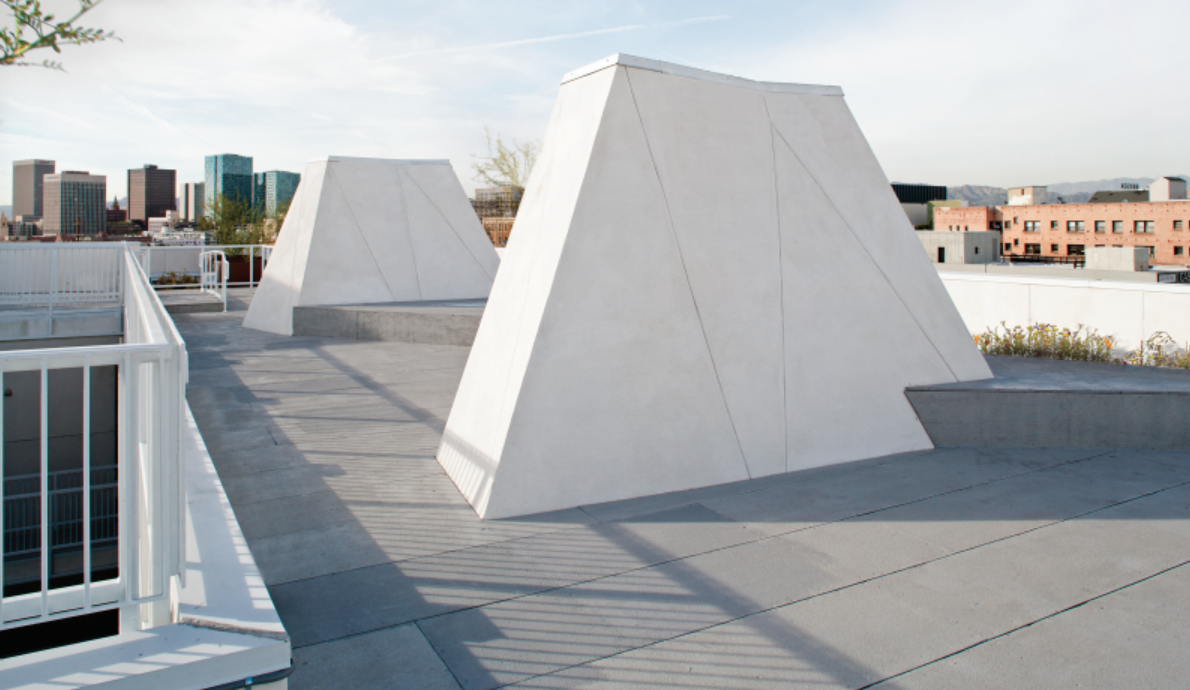
Mechanical systems are enclosed in decorative sculptural forms. “We worked hard to consolidate hundreds of shafts and exhausts so that our roof wouldn’t become a big mechanical zone,” says Larry Scarpa. Photo: Tara Wujcik
The lenders imposed strict—and immovable—timelines on the team. “If you miss the timeline, they revoke your funding. No fees or fines, they just take your money back,” Thepkhounphithack says. It was a constant race against the clock. Very late in the construction schedule, they discovered a misunderstanding about one lender’s deadline. “We had to finish one or two months earlier than scheduled,” she says. The general conrtractor, Golden Bear Construction, had to frame entire floors in a week.
Permitting also proved a headache. Some of the newer materials the team wanted to use, while not that unusual—for example, a new wood composite screen material—the building department wouldn’t allow because its research department hadn’t tested it.
“What’s good enough for every other building department in the world is not good enough for LA,” says Scarpa. Says Thepkhounphithack, “It was an intense process. We basically lived in the building department.”
MAKING A BOLD STATEMENT
The architectural style of The Six was clearly intended to stand out. Thepkhounphithack says the design of the building was about “propelling the neighborhood forward,” rather than just blending in.
The all-white façade of the five-story structure brings a brightness and tranquility to the building and provides a background to the landscaping (by LandStudio 360 and Brooks + Scarpa). The grass in the planters is bright pink when in bloom; the roof plants are red hot pokers. The stark façade provides a dramatic backsplash to these piercing colors as they come into season and change with time, she says.
In addition to earning LEED for Homes Platinum certification, The Six has already captured a slew of prizes: 2017 National AIA Institute Honor, AIA National Housing Award, AIA California Council Honor Award, AIALA Honor Award, and AIA Sustainability Honor Award.
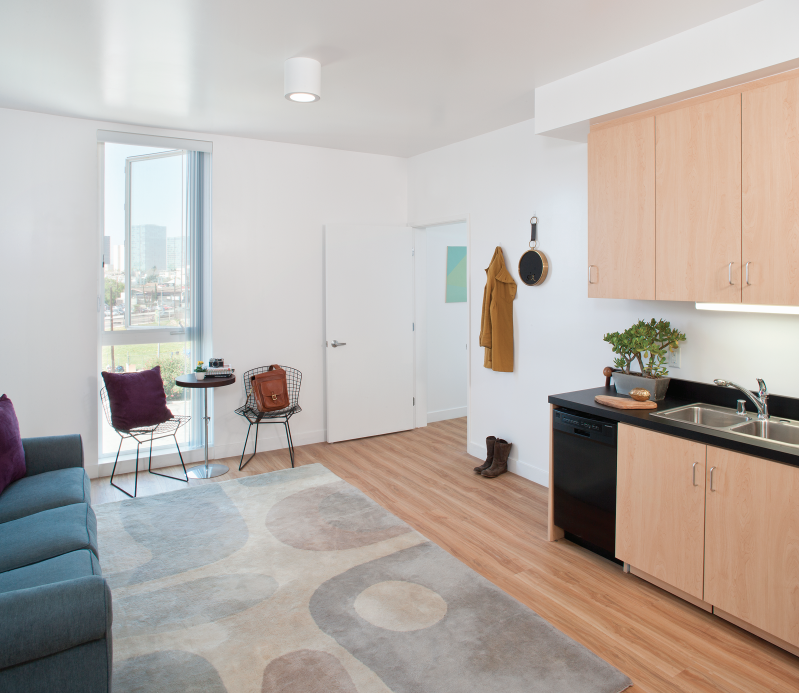
Luxury sheet vinyl flooring helps keep maintenance under control at The Six. Walls were done in semi-gloss paint (level-four smooth finish) for easy cleaning. Units are ADA-adaptable, with zero-step thresholds and roll-in showers or tubs. Photo: Tara Wujcik
For the project team, the true reward has come in how The Six is helping provide elegant housing at affordable rates to those who were previously on the street. This is especially true for the veterans. Says Thepkhounphithack, “It’s good to have them be part of the future instead of being stuck in the past.”
The biggest benefit for the veterans and other formerly homeless residents, says Skid Row Housing Trust’s Diana Pescar, is that The Six induces “a sense of pride about being deserving of living in a nice place.” Her boss, Mike Alvidrez, puts it this way: “We want them to feel proud that this is their home, their community.”
PROJECT TEAM | THE SIX, LOS ANGELES
CLIENT Skid Row Housing Trust, LLC ARCHITECT Brooks + Scarpa STRUCTURAL ENGINEER John Martin & Associates CIVIL ENGINEER Barbara L. Hall, PE MEP ENGINEER Innovative Engineering Group SPECIFICATIONS Phil Easton LANDSCAPE ARCHITECT Brooks + Scarpa; LandStudio 360 GENERAL CONTRACTOR Golden Bear Construction
Related Stories
Multifamily Housing | Mar 31, 2023
EV charging stations in multifamily housing
Ryan Gram, PE, EV Charging Practice Leader at engineering firm Kimley-Horn, provides expert advice about the "business side" of installing EV charging stations in apartment and mixed-use communities. Gram speaks with BD+C Executive Editor Robert Cassidy.
Multifamily Housing | Mar 24, 2023
Washington state House passes bill banning single-family zoning
The Washington state House of Representatives recently passed a bill that would legalize duplexes or fourplexes in almost every neighborhood of every city in the state.
Multifamily Housing | Mar 24, 2023
Momentum building for green retrofits in New York City co-ops, condos
Many New York City co-op and condo boards had been resistant to the idea of approving green retrofits and energy-efficiency upgrades, but that reluctance might be in retreat.
Legislation | Mar 24, 2023
New York lawmakers set sights on unsafe lithium-ion batteries used in electric bikes and scooters
Lawmakers in New York City and statewide have moved to quell the growing number of fires caused by lithium-ion batteries used in electric bikes and scooters.
Multifamily Housing | Mar 24, 2023
Multifamily developers offering new car-free projects in car-centric cities
Cities in the South and Southwest have eased zoning rules with parking space mandates in recent years to allow developers to build new housing with less parking.
Multifamily Housing | Mar 24, 2023
Coastal multifamily developers, owners expect huge jump in insurance costs
In Texas and Florida, where Hurricane Ian caused $50 billion in damage last year, insurance costs are nearly 50% higher than in 2022.
Multifamily Housing | Mar 24, 2023
Average size of new apartments dropped sharply in 2022
The average size of new apartments in 2022 dropped sharply in 2022, as tracked by RentCafe. Across the U.S., the average new apartment size was 887 sf, down 30 sf from 2021, which was the largest year-over-year decrease.
Geothermal Technology | Mar 22, 2023
Lendlease secures grants for New York’s largest geothermal residential building
Lendlease and joint venture partner Aware Super, one of Australia’s largest superannuation funds, have acquired $4 million in support from the New York State Energy Research and Development Authority to build a geoexchange system at 1 Java Street in Brooklyn. Once completed, the all-electric property will be the largest residential project in New York State to use a geothermal heat exchange system.
Urban Planning | Mar 16, 2023
Three interconnected solutions for 'saving' urban centers
Gensler Co-CEO Andy Cohen explores how the global pandemic affected city life, and gives three solutions for revitalizing these urban centers.
Building Tech | Mar 14, 2023
Reaping the benefits of offsite construction, with ICC's Ryan Colker
Ryan Colker, VP of Innovation at the International Code Council, discusses how municipal regulations and inspections are keeping up with the expansion of off-site manufacturing for commercial construction. Colker speaks with BD+C's John Caulfield.


